
 As the world pivots towards sustainable energy sources, hydrogen fuel technology stands out as a pivotal player in the global shift towards decarbonization. According to a report from the International Energy Agency, the demand for hydrogen could reach 200 million tons by 2030, significantly impacting various industries and creating a surge in the need for advanced materials. Central to this evolution is the role of innovative coating solutions that enhance the efficiency and durability of hydrogen fuel systems. Among the cutting-edge technologies emerging in this field is the Hydrogen Fuel Coating Machine, designed to apply protective and functional coatings that prolong the life of components in hydrogen production and utilization. As we explore the future of these innovative coating solutions, it becomes evident that they are integral to achieving the performance requirements laid out in the clean energy transition.
As the world pivots towards sustainable energy sources, hydrogen fuel technology stands out as a pivotal player in the global shift towards decarbonization. According to a report from the International Energy Agency, the demand for hydrogen could reach 200 million tons by 2030, significantly impacting various industries and creating a surge in the need for advanced materials. Central to this evolution is the role of innovative coating solutions that enhance the efficiency and durability of hydrogen fuel systems. Among the cutting-edge technologies emerging in this field is the Hydrogen Fuel Coating Machine, designed to apply protective and functional coatings that prolong the life of components in hydrogen production and utilization. As we explore the future of these innovative coating solutions, it becomes evident that they are integral to achieving the performance requirements laid out in the clean energy transition.
Innovative coating technologies are playing a pivotal role in enhancing the efficiency of hydrogen fuel systems, facilitating the transition to cleaner energy sources. According to a recent report by MarketsandMarkets, the global hydrogen fuel cell market is expected to reach $25.4 billion by 2030, underscoring the growing investment in this sector. High-performance coatings are essential in various components, such as fuel cell membranes and storage tanks, where they improve durability and resist degradation from hydrogen exposure, ultimately leading to enhanced energy output.
 Tip: When selecting coatings for hydrogen applications, consider materials with superior thermal stability and corrosion resistance. Advanced coatings like nano-coatings can significantly improve fuel cell performance by minimizing ion conduction losses and maximizing hydrogen diffusion rates.
Tip: When selecting coatings for hydrogen applications, consider materials with superior thermal stability and corrosion resistance. Advanced coatings like nano-coatings can significantly improve fuel cell performance by minimizing ion conduction losses and maximizing hydrogen diffusion rates.
Moreover, innovations such as hybrid coatings are emerging, combining multiple functionalities to tackle the unique challenges posed by hydrogen environments. A study published in the Journal of Power Sources highlights that these coatings not only enhance performance but can also reduce operational costs by increasing the lifespan of fuel cell components. Pioneer companies are investing in R&D to develop proprietary formulations that can withstand the harsh conditions of hydrogen fuel technology while optimizing efficiency.
Tip: Stay updated on the latest advancements in coating technologies to ensure your hydrogen systems are up-to-date and utilize the best protective measures available for maximum efficiency.
The burgeoning field of hydrogen fuel technology presents unique challenges in the realm of coating solutions. One of the most pressing issues is the corrosive nature of hydrogen, which can lead to degradation of materials used in fuel cells. According to a report by the National Renewable Energy Laboratory (NREL) published in 2022, standards for corrosion resistance in coatings need to evolve alongside advances in fuel cell efficiency, as states that hydrogen can accelerate corrosion rates by up to 30% in certain environments. This highlights the necessity for innovative coatings that not only provide protective barriers but also enhance the overall performance of fuel cells.

Another significant hurdle is the need for coatings to maintain their integrity at high operating temperatures. Research by the U.S. Department of Energy indicates that fuel cell systems often operate around 80°C to 100°C, where traditional coatings may fail. New solutions must incorporate advanced materials like high-performance polymers or nanocoatings that can withstand such conditions without sacrificing functionality. A market analysis by Grand View Research worth approximately $24 billion by 2027 emphasizes the demand for coatings that meet these rigorous performance benchmarks, underscoring the growing importance of research and development in this sector.
The rise of hydrogen fuel technology is fundamentally transforming the energy landscape, and at the forefront of this revolution are innovative coating solutions that ensure efficiency and sustainability. As the demand for greener energy sources increases, the focus on sustainable materials for advanced coating applications is paramount. Utilizing eco-friendly materials not only supports environmental goals but also enhances the durability and performance of components critical to hydrogen technologies.
Advanced coatings made from biodegradable and renewable resources are being developed to address the unique challenges posed by hydrogen fuel systems. These coatings must offer exceptional resistance to corrosion and wear, ensuring long-lasting protection for storage tanks, pipelines, and fuel cells. By integrating nanotechnology and biomimetic designs, researchers are creating coatings that not only meet technical specifications but also reduce the overall environmental impact of hydrogen production and usage.
The significant potential of these sustainable materials lies in their ability to contribute to a circular economy, promoting recyclability and minimizing waste throughout the lifecycle of hydrogen technologies.
The advancements in hydrogen storage systems underscore the critical role of innovative coatings. Recently, research highlighted the application of polyaniline-coated iron oxide nanoparticles to improve the efficiency of microbial fuel cells. This example illustrates how specialized coatings can enhance the performance of hydrogen technologies by optimizing energy production and storage dynamics. By providing a conducting matrix, polyaniline not only boosts the electrical interactions but also offers protection against environmental degradation.
Furthermore, the development of high-entropy alloys showcases how advanced materials can revolutionize solid-state hydrogen storage. These alloys’ unique properties enable them to function effectively as hydrogen permeation barriers, addressing the challenges of hydrogen embrittlement in conventional metals. As the compressed hydrogen energy storage market continues to expand, with projected growth rates highlighting a burgeoning demand, the integration of innovative coating solutions becomes increasingly vital. Such advancements not only enhance storage efficiency but also play a pivotal role in facilitating a sustainable hydrogen economy.
| Coating Type | Primary Function | Hydrogen Storage Capacity Improvement (%) | Durability (Cycles) | Corrosion Resistance (Hours) |
|---|---|---|---|---|
| Ceramic Coatings | Thermal Insulation | 15% | 500 | 1200 |
| Polymer Coatings | Barrier Protection | 10% | 300 | 800 |
| Nanostructured Coatings | Enhanced Permeability | 20% | 700 | 1500 |
| Metallic Coatings | Structural Integrity | 25% | 1000 | 2000 |
The global landscape for innovative coating solutions in the hydrogen fuel technology sector is rapidly evolving, driven by a commitment to clean energy and sustainability. As industries pivot towards low-carbon alternatives, the importance of effective and durable coatings has never been more pronounced. The laser cleaning market, for example, is anticipated to expand from $660 million in 2023 to $1.15 billion by 2032, boasting a compound annual growth rate (CAGR) of 6.36% during this period. This growth reflects the increasing need for advanced surface preparation techniques necessary for hydrogen technology applications.
Moreover, the smart coating market is seeing significant competition among industry leaders striving for a share of this lucrative sector. Recent reports indicate that major players are focusing on innovative materials that enhance efficiency and performance in clean energy solutions. As we approach 2033, the smart coating market is projected to grow significantly, contributing to the overarching goal of energy transition. With countries like China setting aggressive climate targets for 2035, developments in coating technologies will be crucial in meeting these ambitions by promoting cleaner, more efficient energy alternatives.
This chart illustrates the global trends in coating development for clean energy solutions, particularly focusing on hydrogen fuel technology. The data represents the percentage of investment in different innovative coating technologies over the past five years.